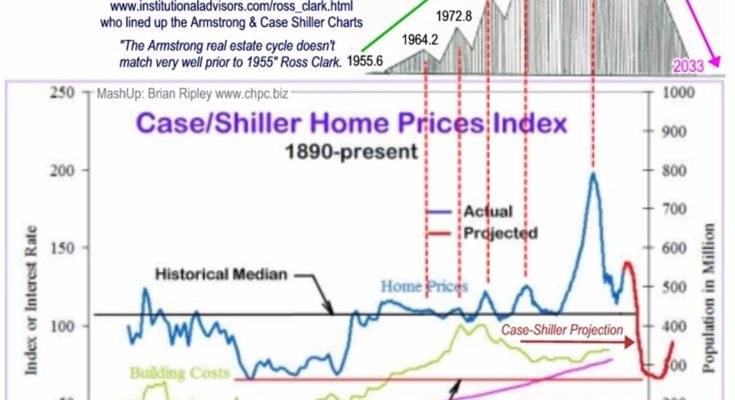
QUESTION:Â Mr. Armstrong, your real estate cycle turned up from 1955. It does not match the Case-Shiller index which peaked in 1890s and bottomed in 1920 and then began to rally after 1940 into the 1955 period. Something seem strange with that index given the huge Florida real estate bubble which burst in 1927. Can you explain why the Case-Shiller seems to be off so much? Here is a chart that has been going around the Web.
Thanks

ANSWER: This is the typical problem with people creating an index and then trying to extend it back in time. They ALWAYS ignore the currency and project purely a domestic view. During the 1890s, J.P. Morgan had to bail out the U.S. Treasury for it was dead broke. As people feared the government would declare bankruptcy, private assets rose in NOMINAL terms. This was matched by the massive exit of foreign capital from the USA.

The Case-Shiller index bottoms in 1920, but this was the point of a massive rise in the dollar’s value. Foreign capital poured into the USA to park because of World War I. This, in turn, led to wild speculation in Florida, which as you correctly stated, burst in 1927. Because rhis isdex is national, it also suppresses regional booms. As real estate peaked in Florida, the hot money then shifted to stocks creating the Phase Transition into 1929. It was this capital flows between asset classes into stocks where that concentration led to the 1929 bubble.
The Case-Shiller index, which suddenly rose from the Great Depression, does not take into account the dollar devaluation that sparked that rise as it did in equities. That was virtually a 60% devaluation of the dollar that moved it from $20 to $35 on a gold standard by FDR. Was that rise “real†or currency related? Sorry, the real rise begins post-war from 1955. That was the real housing boom.
The Case-Shiller does not accurately reflect the changes in currency. One must look at everything in terms of international value before they can see if they really made money or just broke even because the currency declined. From a value perspective, the 1929 high was more than three times that of the 1890s. So the high of the 1890s was purely a rise due to the collapse in the dollar; it was the hallmark of the panic of 1893 and was best expressed in Grover Cleveland’s speech before Congress.

